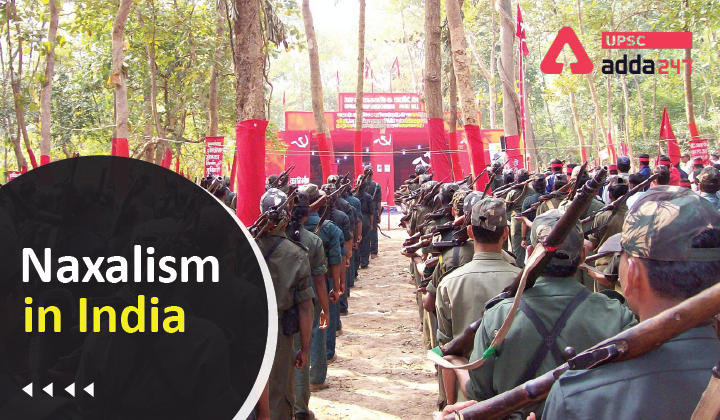Table of Contents
Naxalism in India UPSC
What is naxalism or who are Naxalites?
- Naxalite, earlier known as left extremist, is a general designation given to the several Maoist-oriented and militant insurgent and separatist groups that have operated in India since the mid-1960s.
- While the origin of Left-Wing Extremism (LWE) in the country goes back to the Telangana peasant rebellion (1946-51), the movement took the young republic by storm in 1967.
Naxalism in India: At the time of independence
- Tebhaga Movement started in 1946 and united the peasants.
- Telangana Movement 1946-1951 united the farmers in the area around the now state of Telangana.
- Sino Indian War 1962 gave fuel to the Maoist movement in India after our country lost land to China.
Naxalism: The origin of the name
- The birth of Naxalism is owed to the Naxalbari uprising of spring 1967.
- Naxalbari, the village that gave its name to the movement, was the site of a peasant revolt, instigated by communist leaders against land owners of the State.
- The rebellion gave birth to what would be called the Naxalite movement led by the Charu Majumdar and his close associates, Kanu Sanyal and Jangal Santhal.
- The rebels quickly found support not only amongst the nearby villages, but also from the People’s Republic of China.
- The Communist Party of China’s mouthpiece, People’s Daily, not only called the event “Spring Thunder”, it also devoted an entire editorial page highlighting the importance of the Naxalbari incident.
- Majumdar and Sanyal took initial inspiration from China’s founding father, Mao Zedong, and his tactics to capture political power; the Naxalite movement eventually became radically different from what Maoism stood for.
Phases of naxalism
Phase I
- Communist Party of India (Marxist-Leninist) which followed the ideologies of Marx and Lenin was established in 1969 by Charu Majumdar.
- After the death of Charu Majumdar, the CPI (M-L) became CPI (L-M) Liberation.
- However, the group maintained the same ideology.
Phase II
- People’s War Group was established in 1980 in Andhra Pradesh to fight for the cause of peasants and the landless.
- It was different from CPI (M-L).
- The militia launched a series of attacks, assassinations and bombings targeting landlords, upper-caste leaders and politicians in Andhra Pradesh.
- In the late 1990s, the Andhra Pradesh police forces decimated the PWG.
- Also, the Maoist Communist Centre of India (Bihar) was established.
Phase III
- Andhra Pradesh’s PWG and Bihar’s MCGI were merged to form CPI (Maoist) in 2004.
- Since the formation of CPI(M), the Government of India has declared the Maoists to be one of the biggest internal security threats to the country.
Reasons of spread of naxalism
Land Related Factors
- Evasion of land ceiling laws.
- Existence of special land tenures (enjoying exemptions under ceiling laws).
- Encroachment and occupation of Government and community lands (even the water-bodies) by powerful sections of society.
- Lack of title to public land cultivated by the landless poor.
- Poor implementation of laws prohibiting transfer of tribal land to non-tribals in the Fifth Schedule areas.
- Non-regularisation of traditional land rights.
Displacement and Forced Evictions
- Eviction from lands traditionally used by tribals.
- Displacements caused by irrigation and power projects without adequate arrangements for rehabilitation.
- Large scale land acquisition for ‘public purposes’ without appropriate compensation or rehabilitation.
Livelihood Related causes
- Lack of food security – corruption in the Public Distribution System.
- Disruption of traditional occupations and lack of alternative work opportunities.
- Deprivation of traditional rights in common property resources.
Social Exclusion
- Denial of dignity.
- Continued practice of untouchability in some areas.
- Poor implementation of special laws on prevention of atrocities, protection of civil rights and abolition of bonded labour etc.
Governance Related Factors
- Corruption and poor provision/non-provision of essential public services including primary health care and education.
- Incompetent, ill-trained and poorly motivated public personnel who are mostly absent from their place of posting.
- Misuse of powers by the police and violations of the norms of law.
- Perversion of electoral politics and unsatisfactory working of local government institutions.
Read UPSC favourite topics





 TSPSC Group 1 Question Paper 2024, Downl...
TSPSC Group 1 Question Paper 2024, Downl...
 TSPSC Group 1 Answer key 2024 Out, Downl...
TSPSC Group 1 Answer key 2024 Out, Downl...
 UPSC Prelims 2024 Question Paper, Downlo...
UPSC Prelims 2024 Question Paper, Downlo...




